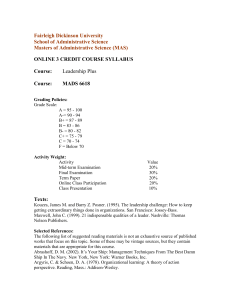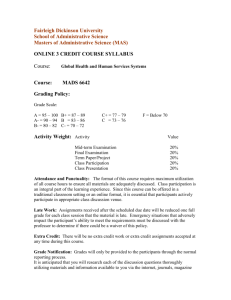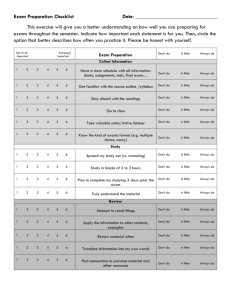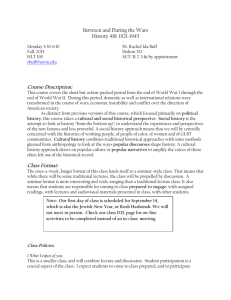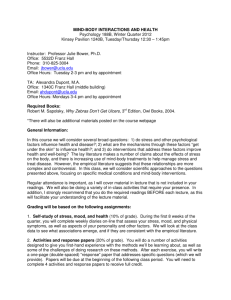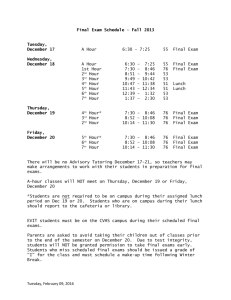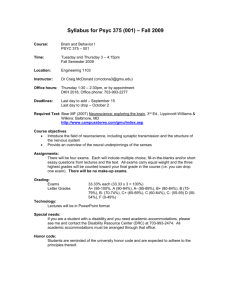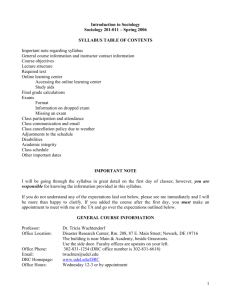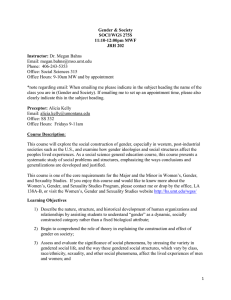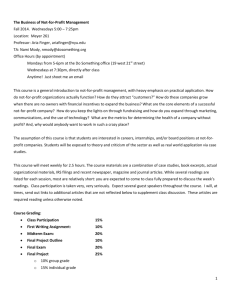Seminar on Strategic Management for - Fdu
advertisement
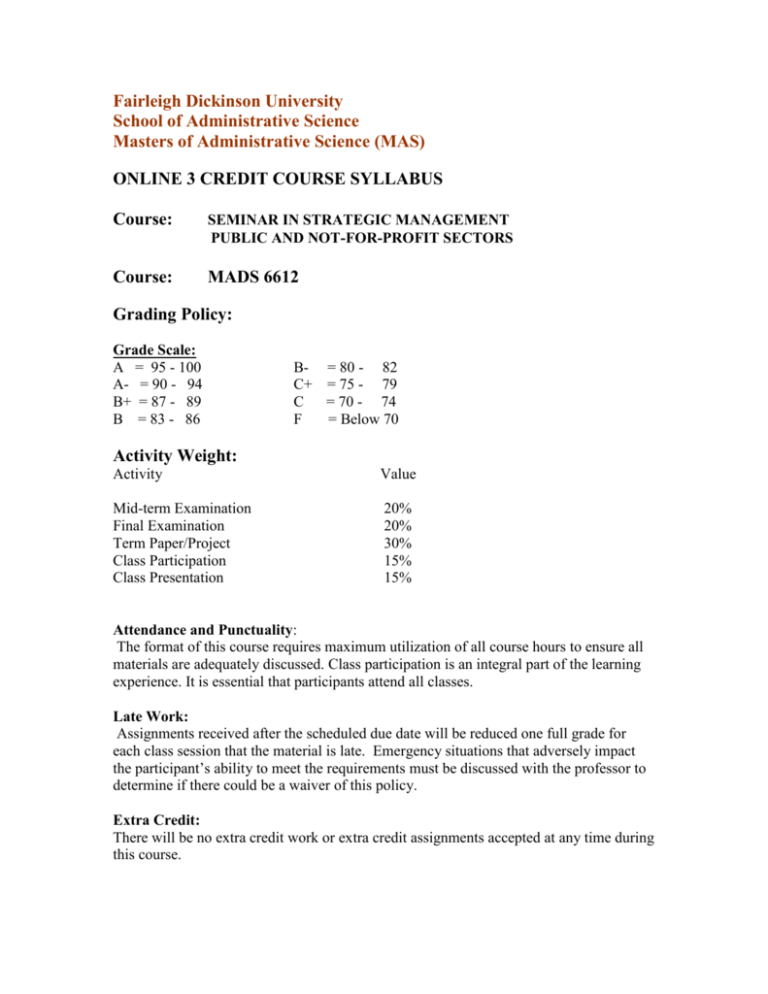
Fairleigh Dickinson University School of Administrative Science Masters of Administrative Science (MAS) ONLINE 3 CREDIT COURSE SYLLABUS Course: SEMINAR IN STRATEGIC MANAGEMENT PUBLIC AND NOT-FOR-PROFIT SECTORS Course: MADS 6612 Grading Policy: Grade Scale: A = 95 - 100 A- = 90 - 94 B+ = 87 - 89 B = 83 - 86 B- = 80 - 82 C+ = 75 - 79 C = 70 - 74 F = Below 70 Activity Weight: Activity Value Mid-term Examination Final Examination Term Paper/Project Class Participation Class Presentation 20% 20% 30% 15% 15% Attendance and Punctuality: The format of this course requires maximum utilization of all course hours to ensure all materials are adequately discussed. Class participation is an integral part of the learning experience. It is essential that participants attend all classes. Late Work: Assignments received after the scheduled due date will be reduced one full grade for each class session that the material is late. Emergency situations that adversely impact the participant’s ability to meet the requirements must be discussed with the professor to determine if there could be a waiver of this policy. Extra Credit: There will be no extra credit work or extra credit assignments accepted at any time during this course. Grade Notification: Grades will only be provided to the participants through the normal reporting process. No grades will be provided to a participant through any electronic medium. Required Text: Bryson, J. M. (1995). Strategic planning for public and nonprofit organizations. San Francisco, CA: Jossey-Bass Publishers. Bryson, J. M., & Alston, F. M. (1996). Creating and implementing your strategic plan: A workbook for public and nonprofit organizations. San Francisco, CA: Jossey-Bass Publishers. Suggested Readings: The following list of suggested reading materials is not an exhaustive source of published works that focus on this topic. Some of these may be vintage sources, but they contain materials that are appropriate for this topic. Allison, M., & Kaye, J. (1997). Strategic planning for nonprofit organizations: A practical guide and workbook. New York: John Wiley & Sons, Inc. Hunger, J. D., & Wheelen, T. L. (1993). Strategic management (4th edition). Reading, Mass.: Addison-Wesley Publishing Company. Mintzberg, H., & Quinn, J. B. (1996). The strategy process: Concepts, contexts, cases (3rd edition). Upper Saddle River, NJ: Prentice Hall Publishers. Rabin, J., Miller, G. J., & Hildreth, W. B. (Eds.). (1989). Handbook of strategic management. New York: Marcel Dekker, Inc. GENERAL COURSE DESCRIPTION: The previous coursework of the Master of Administrative Science (MAS) Program has emphasized functional, product, and program aspects of public and not-for-profit organizations. This course will investigate how public and not-for-profit organizations plan, program, and manage their diverse activities. It is designed to enable you to expand your knowledge of the concepts, practices, techniques, and tools of strategic management used at the upper levels of the organizations. This course provides the participants with tools to formulate strategies that enable the public and not-for profit organizations to adapt to changing social, technological, economic and political conditions. It will provide an opportunity for participants to exercise the knowledge of strategic planning in functional and planning areas. Participants will investigate the strategic planning process used in a public or not-forprofit organization. The course uses readings, lecture, discussion, presentations, and case studies. ENTRANCE COMPETENCIES: It is expected that class participants will be familiar with basic information regarding: ctices used in the public and not-for-profit sector. EXIT COMPETENCIES: By the end of the course, class participants will be able to: es, and practices of long-range planning in a large organization; strategic planning process; Understand the alternative organizational philosophies and their impact on the culture and politics of the organization; al strategies available to the organization to help it meet its goals and objectives. EXAMS AND TERM PAPER REQUIREMENTS: A. Examinations - Examinations will involve short answer and comprehensive essays. The mid-term exam will be returned the following week. The final exam will be graded and returned by mail. The exams will contain no surprises. All questions will be specifically derived from class presentations/readings. There will be no questions derived from materials not discussed in class. For the essay section of the exams, students will be given a series of questions and will be asked to respond to a specific number of items. Exams are to be taken on the date assigned. Exams given on a date other than the scheduled date without prior authorization will contain questions from any aspect of the class presentations and readings, and there will be no choice of questions to which to respond. B. Term Paper - All class participants are expected to prepare a written term paper relevant to strategic planning. Papers will be discussed during the first session. The professor must approve the topic. Students will submit a one-page proposal on their projects by the second class either in hard copy or through email. The purpose of the paper is to exemplify meeting the course objectives as listed in the exit competencies in this syllabus. The emphasis should be on concepts as they apply to descriptive information and not the information itself. Students are expected to demonstrate the use of concepts presented in this course. Papers are expected to be 10 to 15 pages in length (typewritten and double-spaced). The paper should include the following: a) Table of Contents b) Introduction: The introduction should include why you are doing this paper; what is the point. c) Background: The background section provides an assessment of the current organization. It should address the political, organizational, economic, financial, and technological environment. This is a strategic assessment as it pertains to the organization d) Current strategy: This includes the current vision, goals, objectives, philosophy, culture, and strategies for major functional areas e) Brief description of alternative scenarios and associated risks f) Alternative strategies and recommended changes to current posture and processes � recommendations for change to current postures, processes, and strategies to meet challenges of competition and changing environment g) Executive summary � a maximum of two pages, single space summary that summarizes D & F above h) References i) Supplemental materials The long-term trends and the strengths, weaknesses, opportunities, and threats (SWOTs) should also be included in the paper. There should be at least six references from journal articles, textbooks (excluding textbook from this course), or government publications. Supplemental materials to be attached to the end of the paper may include a specific policy, plan, analysis or procedure in effect in your organization. Permission to use the material must be obtained, and the issue of confidentiality must be observed. Inability or failure to attach these materials will not adversely impact on grading. Two copies of the paper are due at the start of the last class. Papers late without good cause will be reduced one letter grade for each day late. All work in this course is expected to be that of the individual student and/or the work of others that is appropriately cited. Any term paper or examination that misrepresents the work of others as that of the student will receive a grade of �0.� Plagiarism is taken seriously at the University and may lead to disciplinary action. C. Presentations - There will be a five to ten minute presentation of the paper on the last day of class. The presentation should provide a summary of the term paper. The presentation will provide an opportunity for other class participants to suggest other aspects to consider. GENERAL CLASS PROCEDURES: Classes will follow the University calendar and will start and end at stated times. Classes will not be canceled unless ordered by the Provost or the Program Director. The instructor reserves the right to alter the syllabus where warranted. Students are expected to take the exams when they are scheduled. In the event that the student cannot take the scheduled exam due to illness or employment-related obligations, a make-up may be offered; however, only one such exam will be scheduled for each exam.
